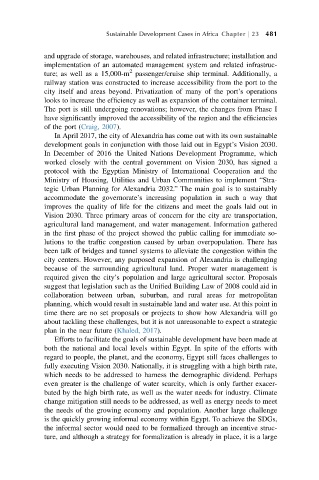Page 512 - Sustainable Cities and Communities Design Handbook
P. 512
Sustainable Development Cases in Africa Chapter j 23 481
and upgrade of storage, warehouses, and related infrastructure; installation and
implementation of an automated management system and related infrastruc-
2
ture; as well as a 15,000-m passenger/cruise ship terminal. Additionally, a
railway station was constructed to increase accessibility from the port to the
city itself and areas beyond. Privatization of many of the port’s operations
looks to increase the efficiency as well as expansion of the container terminal.
The port is still undergoing renovations; however, the changes from Phase I
have significantly improved the accessibility of the region and the efficiencies
of the port (Craig, 2007).
In April 2017, the city of Alexandria has come out with its own sustainable
development goals in conjunction with those laid out in Egypt’s Vision 2030.
In December of 2016 the United Nations Development Programme, which
worked closely with the central government on Vision 2030, has signed a
protocol with the Egyptian Ministry of International Cooperation and the
Ministry of Housing, Utilities and Urban Communities to implement “Stra-
tegic Urban Planning for Alexandria 2032.” The main goal is to sustainably
accommodate the governorate’s increasing population in such a way that
improves the quality of life for the citizens and meet the goals laid out in
Vision 2030. Three primary areas of concern for the city are transportation,
agricultural land management, and water management. Information gathered
in the first phase of the project showed the public calling for immediate so-
lutions to the traffic congestion caused by urban overpopulation. There has
been talk of bridges and tunnel systems to alleviate the congestion within the
city centers. However, any purposed expansion of Alexandria is challenging
because of the surrounding agricultural land. Proper water management is
required given the city’s population and large agricultural sector. Proposals
suggest that legislation such as the Unified Building Law of 2008 could aid in
collaboration between urban, suburban, and rural areas for metropolitan
planning, which would result in sustainable land and water use. At this point in
time there are no set proposals or projects to show how Alexandria will go
about tackling these challenges, but it is not unreasonable to expect a strategic
plan in the near future (Khaled, 2017).
Efforts to facilitate the goals of sustainable development have been made at
both the national and local levels within Egypt. In spite of the efforts with
regard to people, the planet, and the economy, Egypt still faces challenges to
fully executing Vision 2030. Nationally, it is struggling with a high birth rate,
which needs to be addressed to harness the demographic dividend. Perhaps
even greater is the challenge of water scarcity, which is only further exacer-
bated by the high birth rate, as well as the water needs for industry. Climate
change mitigation still needs to be addressed, as well as energy needs to meet
the needs of the growing economy and population. Another large challenge
is the quickly growing informal economy within Egypt. To achieve the SDGs,
the informal sector would need to be formalized through an incentive struc-
ture, and although a strategy for formalization is already in place, it is a large

